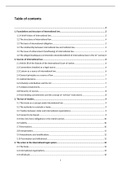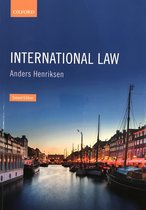Table of contents
..........................................................................................................................................................2
1. Foundations and structure of international law.............................................................................3
1.1 A brief history of international law...............................................................................................3
1.2 The structures of international law...............................................................................................4
1.3 The basis of international obligation............................................................................................5
1.4 The relationship between international law and national law......................................................5
1.5 The issue of enforcement (handhaving) of international law.......................................................5
1.6 The alleged inadequacy (vermeende ontoereikendheid) of international law in the 21 st century5
2. Sources of international law..........................................................................................................6
2.1 Article 38 of the Statute of the International Court of Justice......................................................6
2.2 Conventions (treaties) as a legal source.......................................................................................6
2.3 Custom as a source of international law.......................................................................................6
2.4 General principles as a source of law............................................................................................7
2.5 Judicial decisions...........................................................................................................................7
2.6 Scholarly contributions and the ILC..............................................................................................7
2.7 Unilateral statements...................................................................................................................7
2.8 Hierarchy of sources.....................................................................................................................8
2.9 Non-binding commitments and the concept of ‘soft law’ instruments........................................8
3. The law of treaties.........................................................................................................................9
3.1 The treaty as a concept under international law..........................................................................9
3.2 The authority to conclude a treaty...............................................................................................9
3.3 Treaties between states and international organizations.............................................................9
3.4 Consent to be bound....................................................................................................................9
3.5 Entry into force-obligations in the interim period......................................................................10
3.6 Validity........................................................................................................................................10
3.7 Reservations...............................................................................................................................10
3.8 Interpretation.............................................................................................................................11
3.9 Amendments and modifications.................................................................................................12
3.10 Termination and withdrawal....................................................................................................12
4. The actors in the international legal system................................................................................13
4.1 The State.....................................................................................................................................13
4.2 International organizations.........................................................................................................15
4.3 Individuals...................................................................................................................................16
1
, 4.4 Other actors in international law................................................................................................16
5. Jurisdiction..................................................................................................................................17
5.1 Jurisdiction to prescribe..............................................................................................................17
5.2 Jurisdiction to enforce................................................................................................................18
6. Immunity from national jurisdiction and diplomatic protection..................................................20
6.1 State immunity...........................................................................................................................20
6.2 The immunities of state representatives....................................................................................21
6.3 Diplomatic immunities and protection.......................................................................................22
7. State responsibility......................................................................................................................24
7.1 The basic principles of state responsibility.................................................................................24
7.2 Attribution of conduct................................................................................................................24
7.3 State responsibility in relation to acts of other states................................................................25
7.4 Circumstances precluding wrongfulness....................................................................................25
7.5 Consequences of wrongful conduct............................................................................................26
7.6 Who may invoke a breach of international law?........................................................................27
7.7 Diplomatic protection.................................................................................................................27
7.8 The international responsibility of international organizations..................................................27
12. The peaceful settlement of disputes..........................................................................................29
12.1 Non-adjudicatory means of settling international disputes......................................................29
12.2 Arbitration................................................................................................................................29
12.3 The International Court of Justice.............................................................................................29
12.4 International courts and tribunals with a specialized mandate................................................31
13. The international regulation of the use of force.........................................................................32
13.1 The UN Charter and the prohibition on the use of force..........................................................32
13.2 The Security Council and the maintenance of international peace and security......................32
13.3 The unilateral use of force by states.........................................................................................33
13.4 Contentious use of force...........................................................................................................34
2
, 1. Foundations and structure of international law
Public international law reflects the society to which it applies and it’s the legal system that deals
with issues of concern to more than one state. The practical relevance of international law increases.
1.1 A brief history of international law
The international law was invented in Europe in the late Middle Ages (15th and 16th centuries). For
example, you can think of the Holy Roman Empire (universal political forces) and the Catholic Church
(universal religious forces). In these centuries, there was the theory of natural law (jus naturale),
with next to it the law of people/nations (jus gentium). There wasn’t a structure of the international
law, but there were numerous legal obligations and contracts created at the time. The period was
also the beginning of colonialism. The Spanish Dominican professor Francisco de Vitoria concluded
that the native populations of these colonised countries were part of the society of the human race
and that the Spanish conquistadores therefore were governed by the natural law. The modern law
system began to develop in the 17th and 18th centuries.
1.1.1 Peace of Westphalia
The Peace of Westphalia (1648) ended the Thirty Years War in Europe and it’s being seen as the
beginning of the international state system. In the peace treaties of Westphalia, the European
countries established a semblance of order and structure in the European world. The powers of
transnational forces (empire and religion) needed to reduce and the territory and individuals needed
to be organized in sovereign states. The states were now of equal legal importance. The state was
now the primary source of authority and it’s the most important legal actor in the international
system. This concept spread to the rest of the world quickly. An important French lawyer, Jean Bodin
(1530-1596), had developed the theory of a sovereign possessing who is absolute and indivisible,
who would be above the law and society and was bound by no one. Later on, this conception was
being supplemented by the conceptions of sovereignty developed by Thomas Hobbes (1588-1679)
and John Locke (1632-1704).
1.1.2 The 19th century and the era of positivism
The 19th century was the century of positivism: states could be judged according to whether or not
they conformed to transcendent ideals of fairness or divine will (goddelijke wil). The only true source
of international law was state will. A state needed to consent to be bound by a rule, otherwise an
international law obligation didn’t exist (consensual theory). There were a couple of formal
institutions established, including the permanent Court of Arbitration in The Hague (1907). While
most countries in South America became independent from the European colonizers, still 90 percent
of Africa was under European control at the outbreak of the First World War in 1914.
1.1.3 The interwar period
After the First World War, the League of Nations was created in 1919: an organization that needed
to maintain world peace. States were required to submit potential disputes, desist from resorting to
war until a certain period had elapsed following the decision by that mechanism. The Treaty of Paris
obligated states to refrain from going to war as a way of showing their international controversies
(strijdpunt) and as an instrument of national policy. Also, the Permanent Court of International
Justice was being established in The Hague.
1.1.4 The period after the end of the Second World War
This period was very important for the international law. After the war, top German officials were
being prosecuted before a war crimes tribunal in Nuremberg, thereby setting a precedent in
3
, international criminal law. The League of Nations was replaced by the United Nations. They needed
to maintain world peace and security. The Charter of the United Nations was the founding treaty
(oprichtingsverdrag) and the Security Council had to maintain international peace and security with
measures if necessary. However, during the Cold War, the Security Council was mostly inactive. It
was after the collapse of communism and the expulsion of Iraq from Kuwait in 1991 that the Security
Council began to live. The member states were represented in the General Assembly where they can
tell their opinions and raise their concerns. The General Assembly played an important role in the
decolonialization process. Also, the General Assembly established the International Law Commission
(ILC). With the establishment of the United Nations, the International Court of Justice (ICJ) replaced
the Permanent Court of International Justice (PCIJ).
There were a couple of international organisations created during this period: the International
Monetary Fund (ensure exchange stability and provides resources for states with payments
difficulties), the International Bank for Reconstruction and Development (‘World Bank’, provides
loans to developing countries), and the General Agreement on Tariffs and Trade (reducing tariffs and
other barriers to liberalize the world trade). In 1995, the World Trade Organization (WTO) replaced
the General Agreement on Tariffs and Trade (GATT).
An important regional organization is the North Atlantic Treaty Organization (NATO) whose
members agree to offer each other mutual defence during an attack by an external actor. It was
created in 1949, during the Cold War. Institutional cooperation in Europe led to the European Union
(EU). First it was an cooperation for a common market for coal and steel. Later on, it became the
European Economic Community with an economic common market. In 1992, the Maastricht Treaty
created the European Union. The European Union contains a number of important institutions: the
European Security Council, the Security Council of the European Union, the European Parliament, the
European Commission and the Court of Justice of the European Union.
1.1.5 The present
Most of the international institutions were set up to create a world based on Western values.
Nowadays, it shows some tensions. The world has become more ‘multipolar’ with global
transformations, such as the rise of China and Russia’s unlawful annexation of Crimea in 2014. The
increasing international competition means that major states seem increasingly unable to reach
agreement on ambitious collaborative efforts to create new legally binding global agreements on
important contemporary issues.
1.2 The structures of international law
Since the Peace of Westphalia in 1648, the sovereign states are the centres of the international
system. Therefore, the international society is a society of individual national states. International
law is a supplement on the national law. If there is an issue of interest to more than one state, it is
international law that provides the answer. There are two ways in which an issue becomes of interest
to more than one state that determines the two structures of international law: two or more states
may have colliding interests in the substance of the issue (the international law of coexistence) or
the involved states have agreed in a treaty to turn the issue into one of an international character
(the international law of cooperation).
1.2.1 The international law of coexistence
The international law of coexistence plays a role when there are two or more states who have
colliding interests in the substance of an issue. The international law is mostly horizontal in the sense
that sovereign states interact with each other. It seeks to ensure that states can put aside their
different and separate interests in a way that respects the sovereignty and rights of other states.
4






